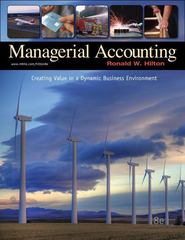Answered step by step
Verified Expert Solution
Question
1 Approved Answer
1)Wolf Company issued 1,000 of its $1,000 face amount, 20-year bonds on June 30, 2010, for $1,020,000. Each bond carries five detachable stock purchase warrants,
1)Wolf Company issued 1,000 of its $1,000 face amount, 20-year bonds on June 30, 2010, for $1,020,000. Each bond carries five detachable stock purchase warrants, each of which entitles the holder to purchase for $60 one share of Wolfs common stock. On June 30, 2010, the market prices were $50 per share of Wolfs common stock and $5 per warrant. In its June 30, 2010, balance sheet, at what amount should Wolf report the carrying amount of the bonds? a. $995,000 b. $1,000,000 c. $1,020,000 d. $1,045,000 2) Information relating to the capital structure of Parke Corporation is as follows: ` December 31 2008 2009 Outstanding shares of: Common stock 90,000 90,000 Preferred stock, convertible into 30,000 shares of common 30,000 30,000 10% convertible bonds, convertible into 20,000 shares Of common $1,000,000 $1,000,000 During 2009 Parke paid $45,000 dividends on the preferred stock, which is considered a common stock equivalent. The convertible bonds are not considered common stock equivalents. Parkes net income for 2009 was $980,000 and the income tax rate was 40%. A). For the year ended December 31, 2009, the primary earnings per share is: a. $10.89 b. $10.39 c. $8.17 d. $7.79 B) For the year ended December 31, 2009, the fully diluted earnings per share is: a. $9.82 b. $8.29 c. $7.71 d. $7.43 3) On January 4, 2002, Wynn, Inc., bought 15% of Parr Corporations common stock for $60,000. Wynn appropriately accounts for this investment by the cost method. The following data concerning Parr are available for the years ended December 31, 2002 and 2003: 2002 2003 Net income $30,000 $90,000 Dividend paid None 80,000 In its income statement for the year ended December 31, 2003, how much should Wynn report as income from this investment? a. $4,500 b. $9,000 c. $12,000 d. $13,500 4)Burr Corporation began operations on January 1, 2007, and at December 31, 2007, Burr had the following investment portfolio of marketable equity securities: In current assets In noncurrent assets Aggregate cost $185,000 $275,000 Aggregate market value 150,000 225,000 Net unrealized loss $ 35,000 $ 50,000 All the declines are judged to be temporary. Valuation allowances at December 31, 2007 should be established with corresponding charges against: Income Stockholders equity a. $ -0- $85,000 b. 35,000 50,000 c. 50,000 35,000 d. 85,000 -0- 5) On February 24, 2006, Bart Company purchased 2,000 shares of Winn Corporations newly issued 6% cumulative $75 par preferred stock for $152,000. Each share carried one detachable stock warrant entitling the holder to acquire at $10, one share of Winn no-par common stock. On February 25, 2006, the market price of the preferred stock was $72 a share and the market price of the stock warrants was $8 a warrant. On December 29, 2006, Bart sold all the stock warrants for $20,500. The gain on the sale of the stock warrants was: a. $-0- b. $ 500 c. $ 4,500 d. $ 5,300 6) During 2004 Rex Company purchased marketable equity securities as a trading investment. The cost and market value at December 31, 2004, were as follows: Security Cost Market value A 100 shares $ 2,800 $ 3,400 B 1,000 shares 17,000 15,300 C 2,000 shares 31,500 29,500 $51,300 $48,200 Rex sold 1,000 shares of Company B stock on January 31, 2005, for $15 per share, incurring $1,500 in brokerage commission and taxes. On the sale, Rex should report a realized loss of: a. $300 b. $1,800 c. $2,000 d. $3,500 7) When the market value of an investment in debt securities exceeds its carrying amount, how should the asset be reported at the end of the year for each of the following? Available-for-sale Held-to-maturity Marketable securities marketable debt securities a. Amortized cost Market b. Market Amortized cost c. Amortized cost Amortized cost d. Market Market 8). On June 30, 2008, Eddy Corporation had outstanding 8%, $2,000,000 face value convertible bonds maturing on June 30, 2018. Interest is payable on June 30 and December 31. Each $1,000 bond is convertible into 40 shares of Eddys $20 par common stock. After amortization through June 30, 2008, the unamortized balance in the premium on bonds payable account was $50,000. On June 30, 2008, 1,000 bonds were converted when Eddys common stock had a market price of $30 per share. Under the book value method, what amount should Eddy credit to additional paid-in capital in recording the conversion? a. $425,000 b. $400,000 c. $225,000 d. $200,000 9) Robin Co. has a marketable equity securities portfolio classified as a noncurrent available-for-sale. None of the holdings enables Robin to exercise significant influence over an investee. The aggregate cost exceeds its aggregate market value. The decline is considered temporary and should be reported as a (an): a. Unrealized loss in the income statement. b. Realized loss in the income statement. c. Valuation allowance in the noncurrent liability section of the balance sheet. d. Valuation allowance in the asset section of the balance sheet
Step by Step Solution
There are 3 Steps involved in it
Step: 1

Get Instant Access to Expert-Tailored Solutions
See step-by-step solutions with expert insights and AI powered tools for academic success
Step: 2

Step: 3

Ace Your Homework with AI
Get the answers you need in no time with our AI-driven, step-by-step assistance
Get Started


